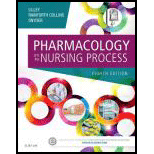
To discuss:
The pathophysiology of vomiting and nausea including its specific precipitating factors and/or diseases.
Concept introduction:
Vomiting and nausea are the two gastrointestinal disorders. The unpleasant feeling that leads an urge in vomiting is called nausea. The forcible expulsion or emptying of intestinal contents through the mouth is called emesis or vomiting. A variety of stimuli are involved in triggering the feeling of nausea and vomiting are unpleasant sights, foul smell or taste, stomach or intestinal irritation, and the use of certain drugs.
Explanation of Solution
Vomiting center is responsible for the initiation of vomiting and nausea. Vomiting center is the area of the brain that is involved in the stimulation of nausea and vomiting. The chemoreceptor trigger zone (CTZ) is another area of the brain, which is also involved in the induction of vomiting and nausea. It sends neurotransmitter signals to the vomiting center about the presence of nauseating substances in the body. These signals alert the brain to expel the nauseating substances out from the body. The vomiting reflex will be initiated with the stimulation of CTZ and the vomiting center.
The neurotransmitters that are involved in the vomiting pathway includes acetylcholine (ACh), dopamine (D2), histamine (H1), prostaglandins, serotonin (5-HT3), and substance P (Neurokinin 1).
The various areas or pathways that are involved in sending signals to the vomiting center in the brain are gastrointestinal tract, cerebral cortex, and labyrinth (inner ear).
The symptoms of vomiting could occur due to various factors such as stress, illnesses, and certain medications. Apart from this, two specific types of factors are also involved, such as post-operative and chemotherapy-induced nausea and vomiting.
The pathophysiology of nausea and vomiting, including its specific factors is discussed.
Want to see more full solutions like this?
Chapter 52 Solutions
Pharmacology and the Nursing Process, 8e
- true or false dark skinned infants should be screened for vitamin D levelsarrow_forwardtrue or false any practice employee is authorized to and should communicate collection guidelines with practice?arrow_forwardrtrue or false equesting a listing of specific creditreferences during patient intake os an acceptable business practice?arrow_forward
- give an overview on the respiratory assessmentarrow_forwardexplain an abdominal exam?arrow_forwardDiscuss β -Lactam antibiotics under the following subheadings Classifications of penicillins Classification of Cephalosporins General Mechanism of Actions Clinical Indications of penicillins and cephalosporins Adverse effects of β-lactamsarrow_forward
- a. Define neoplasm b. Differentiate between benign and malignant tumours c. Describe the molecular basis of cancerarrow_forwarddifferentiate the extra heart sounds S3,S4, murmurs and gallopsarrow_forward• Define shock and list types of shock • Discuss pathogenesis of septic shock. • Enumerate the stages of shock. • Define oedema and describe the pathophysiologic mechanisms of oedema with examples.arrow_forward
- Discuss Hypertension under the following headings: Definition Diagnosis Non-pharmacological intervention Drugs Classification Management of a Hypertensive emergencyarrow_forwardExplain how the answer could be 2 or 1.8 WITHOUT changing the questionarrow_forwardoverview of the neurological system, cranial nerves and what part of the body it innervatesarrow_forward
 Phlebotomy EssentialsNursingISBN:9781451194524Author:Ruth McCall, Cathee M. Tankersley MT(ASCP)Publisher:JONES+BARTLETT PUBLISHERS, INC.
Phlebotomy EssentialsNursingISBN:9781451194524Author:Ruth McCall, Cathee M. Tankersley MT(ASCP)Publisher:JONES+BARTLETT PUBLISHERS, INC. Gould's Pathophysiology for the Health Profession...NursingISBN:9780323414425Author:Robert J Hubert BSPublisher:Saunders
Gould's Pathophysiology for the Health Profession...NursingISBN:9780323414425Author:Robert J Hubert BSPublisher:Saunders Fundamentals Of NursingNursingISBN:9781496362179Author:Taylor, Carol (carol R.), LYNN, Pamela (pamela Barbara), Bartlett, Jennifer L.Publisher:Wolters Kluwer,
Fundamentals Of NursingNursingISBN:9781496362179Author:Taylor, Carol (carol R.), LYNN, Pamela (pamela Barbara), Bartlett, Jennifer L.Publisher:Wolters Kluwer, Fundamentals of Nursing, 9eNursingISBN:9780323327404Author:Patricia A. Potter RN MSN PhD FAAN, Anne Griffin Perry RN EdD FAAN, Patricia Stockert RN BSN MS PhD, Amy Hall RN BSN MS PhD CNEPublisher:Elsevier Science
Fundamentals of Nursing, 9eNursingISBN:9780323327404Author:Patricia A. Potter RN MSN PhD FAAN, Anne Griffin Perry RN EdD FAAN, Patricia Stockert RN BSN MS PhD, Amy Hall RN BSN MS PhD CNEPublisher:Elsevier Science Study Guide for Gould's Pathophysiology for the H...NursingISBN:9780323414142Author:Hubert BS, Robert J; VanMeter PhD, Karin C.Publisher:Saunders
Study Guide for Gould's Pathophysiology for the H...NursingISBN:9780323414142Author:Hubert BS, Robert J; VanMeter PhD, Karin C.Publisher:Saunders Issues and Ethics in the Helping Professions (Min...NursingISBN:9781337406291Author:Gerald Corey, Marianne Schneider Corey, Cindy CoreyPublisher:Cengage Learning
Issues and Ethics in the Helping Professions (Min...NursingISBN:9781337406291Author:Gerald Corey, Marianne Schneider Corey, Cindy CoreyPublisher:Cengage Learning





